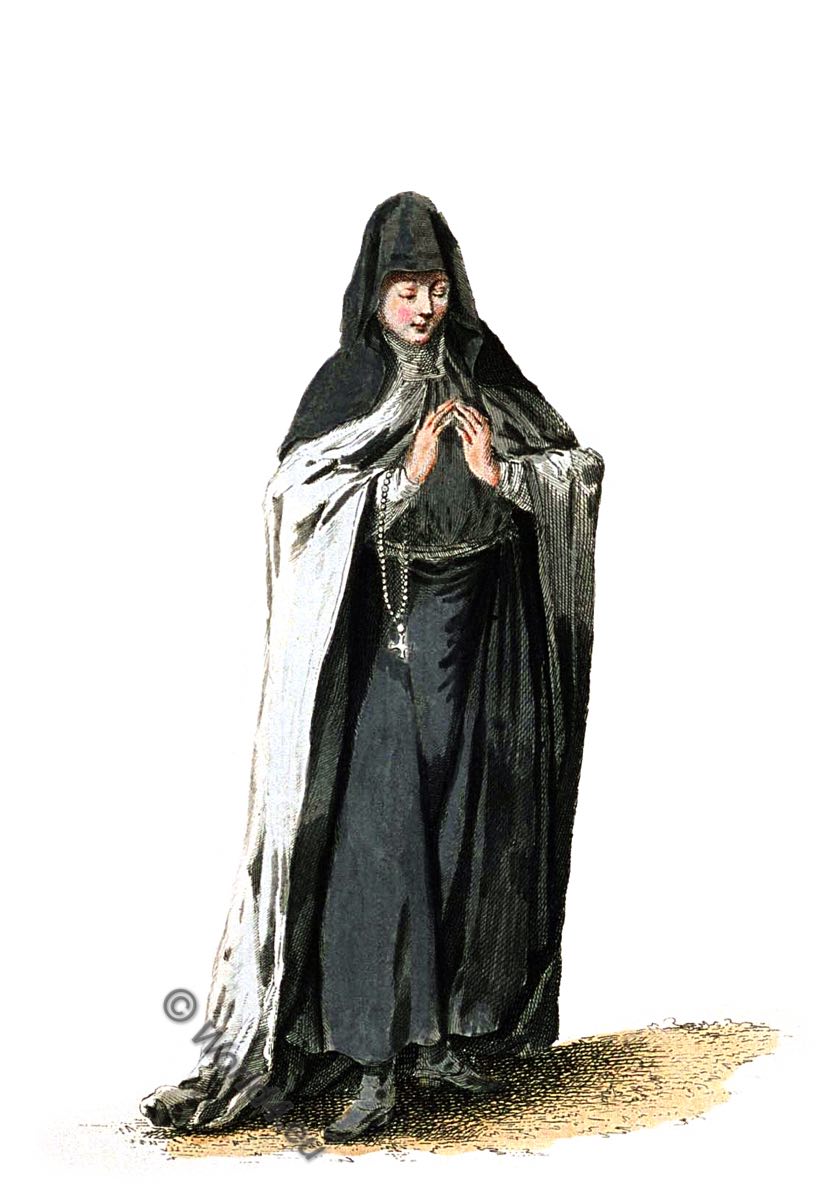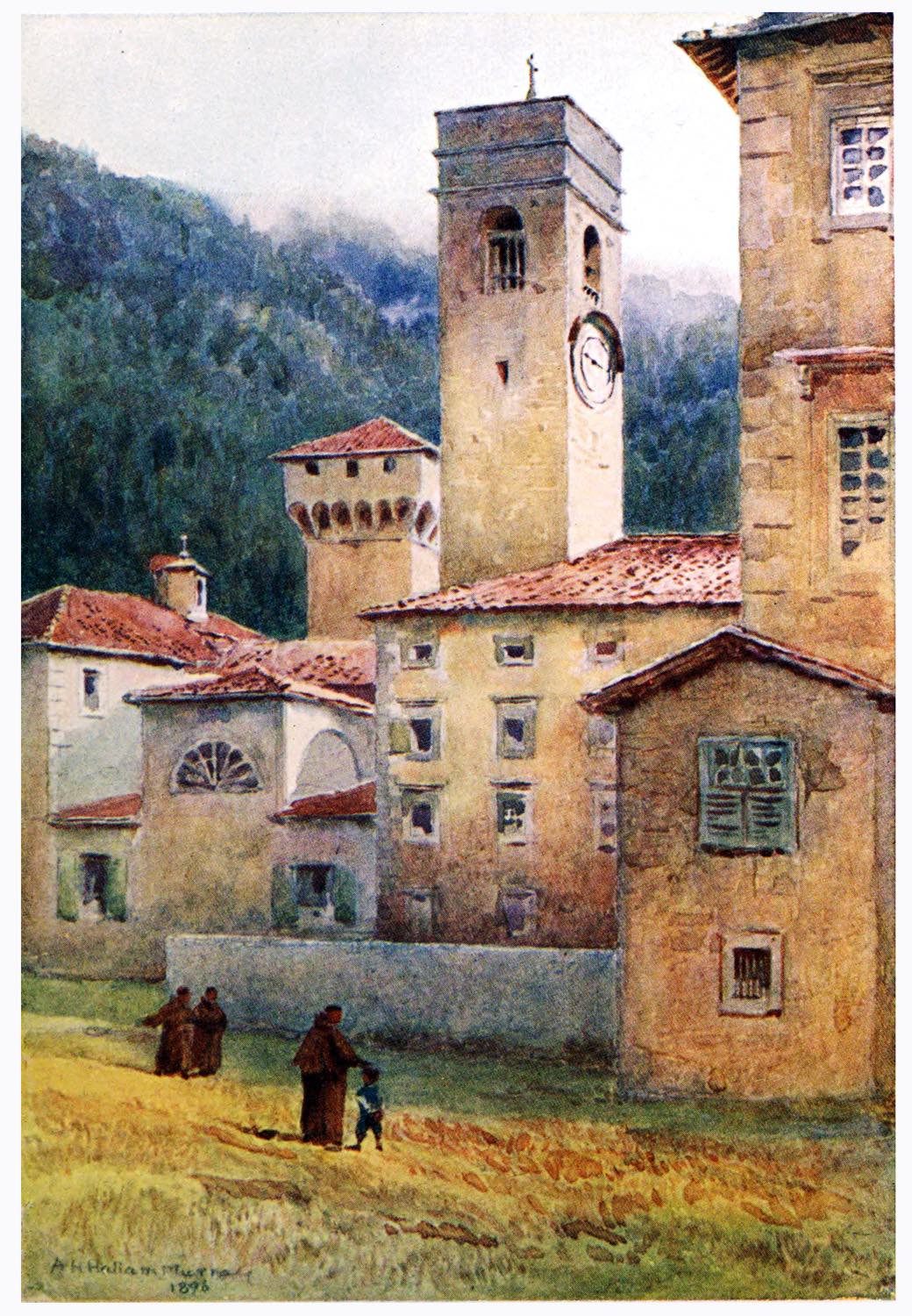HISTORY OF RELIGIOUS ORDERS.
BENEDICTINE NUNS.
History of the Benedictine Order (Latin: Ordo Sancti Benedicti, abbreviated as OSB).
EARLY NUNS OF THE ORDER OF ST. BENEDICT. – OUR LADY OF CALVARY. FONTEVRAULT. – BENEDICTINE NUNS OF THE PERPETUAL ADORATION.
THE date of the first establishment of monasteries of women following the Benedictine Rule, is uncertain, and authors who have written on this subject differ in their opinions, some asserting that nuns of the Order of St. Benedict existed during the lifetime of the holy founder, while others maintain that they were established only after his death.
In the year 544, St. Radegund, wife of Childebert I., king of France, built the Monastery of the Holy Cross at Poitiers, for women. The rule of St. Cæsarius was at first observed in this monastery, but it was superseded by that of St. Benedict. Gradually the various monasteries in France began to observe the rule of the great Patriarch of the monks of the West. The Benedictine nuns, like the monks, passed through various periods of relaxation and reformation. One of these reformations took place in the ancient abbey of Notre Dame of St. Paul, near Beauvais, by the untiring efforts of the abbess, Madeleine d’Esconbleau de Sourdis. She reestablished the cloister, labor in common, Matins after midnight, and the Benedictine habit. This same abbess also became instrumental in the reformation of several other monasteries. She died in 1665, aged 85 years.
Another reformation was that of Our Lady of Calvary in the seventeenth century, founded at Poitiers by Father Joseph Le Clerc du Tremblay,*) a Capuchin Friar, and according to several authorities, by Antoinette d’Orleans. The nuns of this order observed the rule of St. Benedict with great rigor. It was confirmed by Pope Gregory XV., and it may, in a certain sense, be considered a branch of the Cistercian order, as Antoinette d’Orleans belonged to the Feuillantes, who followed the Rule of Citeaux. The habit of these nuns is brown, with a white scapular. In choir they wear a black mantle. They are bare footed from the first of May until the feast of the Exaltation of the Holy Cross in September.
*) Père Joseph, actually François-Joseph Le Clerc du Tremblay de Maffliers, 1577-1638. Père Joseph’s great political influence as confessor to Cardinal Richelieu led to the expression “grey eminence” or éminence grise (who operates “behind the scenes”).
One of the most singular orders in the Church was that of Fontevrault.1) It was founded about the year 1100, by Blessed Robert d’Arbrissel. It may be called a double order, as it consisted of both sexes, who lived in separate monasteries. That which appears most striking is the fact that the superior of the order was a woman, the abbess of the nuns.2) This rule was made by the founder to honor the Blessed Virgin, to whom Christ, dying on the cross, had recommended His beloved disciple, St. John. The order was confirmed by the Holy See in 1113. The first superior was Herlande de Champagne, and the first abbess Petronilla de Craon Chemillé (October 28, 1115), widow of the baron of that name. The order was placed under the rule of St. Benedict.
1) Abbaye royale Notre-Dame de Fontevraud (old spelling Fontevrault; lat. Abbatia Fontis-Ebraldi). King Henry II of England had himself buried at Fontevraud in 1189, as did his son Richard the Lionheart (1199) and his wife Eleonore (1204), making the abbey one of the most important dynastic burial sites in Middle Ages Europe.
2) Despite its originality, Fontevraud was essentially an order of women in the eyes of its aristocratic female members – a vision shared by the popes, as evidenced by the numerous privileges always addressed exclusively to abbesses and female religious.
The constitutions required perpetual abstinence from flesh-meat. The nuns were obliged to observe continual silence, and to go to and from the church together. Their face was always covered with a veil, and their habit was made of coarse material. No religious was allowed to leave the cloister without the permission of the abbess.
The monks led a life of community, and recited the Office in common. The reception of members into the order belonged to the abbess.
There was at one time at Fontevrault as many as four or five thousand nuns.*) The order acquired a great reputation, spread throughout France, and it was introduced into Spain and England.
In the course of time, it lost its first fervor, and became greatly relaxed, but several of the abbesses exerted themselves to their utmost ability to introduce a reform which finally succeeded, and which was confirmed by Pope Sixtus IV.
The nuns of Fontevrault were mostly noble ladies, and to them was entrusted the education of the royal princesses. The order of Fontevrault was suppressed during the French Revolution, but in 1803 the female branch was re-established in France for the purpose of devoting itself to the education of youth.
Benedictine Nuns of Perpetual Adoration of the Blessed Sacrament.
An order in which the Rule of St. Benedict is rigidly observed is that of the Benedictine Nuns of the Perpetual Adoration. It was founded by Mother Mechtildis of the Blessed Sacrament, born in 1614. Her name in the world was Catherine de Bar. Her childhood having been spent in great piety, in her seventeenth year she entered the Order of the Annonciades at Bruyeres, and she was there professed, having taken the name of Sister St. John the Evangelist. At the age of 20 or 21 she became superior of her monastery. In 1635 the wars that were then raging in Lorraine dispersed her community, and, for three years, she remained among seculars, not being able to find a monastery where she might abide.
In 1639, haying deliberately considered the matter before God, she left her order and entered that of the Benedictines at Rambervilliers, where the Rule was strictly observed, taking the name of Mechtildis of the Blessed Sacrament. She there made her profession in 1640.
The troubled times and extreme desolation which prevailed in Lorraine again forced her to leave her monastery, together with other religious, and she was charitably received at the abbey of Montmartre at Paris. In 1643 her community was again assembled at Saint Maur. Some time after she became superior, first of the monastery of Caen, and later of that of Rambervilliers. Having returned to Paris, she made the acquaintance of several noble ladies, by the aid of whom she succeeded in establishing a monastery at Saint-Germain-des-Prés, where she introduced the devotion of the Perpetual Adoration of the Blessed Sacrament, and laid the foundation of her order, in which the religious bind themselves by vow to the practice of this devotion. The sisters take turns in the performance of this act of piety.
Another practice of the order is that of perpetual reparation. Every morning, before the conventual Mass, one of the sisters places herself in the middle of the choir with a torch in her hand and a rope around her neck, and remains thus during the Holy Sacrifice to repair the injuries done to the Blessed Sacrament. The one whose turn it is to make reparation also goes to the refectory with the rope around her neck and the torch in her hand, and kneeling down before her sisters, says: “Praised and adored be forever the Most Holy Sacrament of the Altar. My dear sisters, remember that we are consecrated to God as victims to repair the outrages and profanations constantly committed against the Most Holy Sacrament of the Altar. I humbly beg the assistance of your prayers in order to acquit myself worthily of this duty.” She then spends the day in retreat until Vespers.
Every morning after Mass the sisters lie prostrate, and one of them pronounces an act of adoration. Every hour of the day and night five strokes of the bell are given as a reminder of the benefit conferred on us by the Holy Eucharist. Their ordinary salutation to one another consists of the words: “Praised forever be the Most Holy Sacrament of the Altar.” A figure of the Bessed Sacrament, made of gilt copper, is worn by each sister on her scapular or on the habit she wears in the choir. The Blessed Sacrament is always exposed on Thursdays, and the sisters remain on that day, as much as possible, in prayer.
Mother Mechtildis established the Perpetual Adoration in several other monasteries. In 1687 the order was introduced into Poland. The foundress, after a life of great virtue and eminent sanctity, died on April 6th, 1698, at the age of 83.
The constitutions of the order were confirmed in 1676 by Pope Innocent XI., having previously in 1668 been approved by the Cardinal de Vendome, Papal Legate in France. They were again confirmed in 1705 by Pope Clement XI.
Source: History of religious orders. A compendious and popular sketch of the rise and progress of the principal monastic, canonical, military, mendicant, and clerical orders and congregations of the Eastern and Western churches, together with a brief history of the Catholic church in relation to religious orders by Charles Warren Currier. New York, Murphy & McCarthy, 1894.







